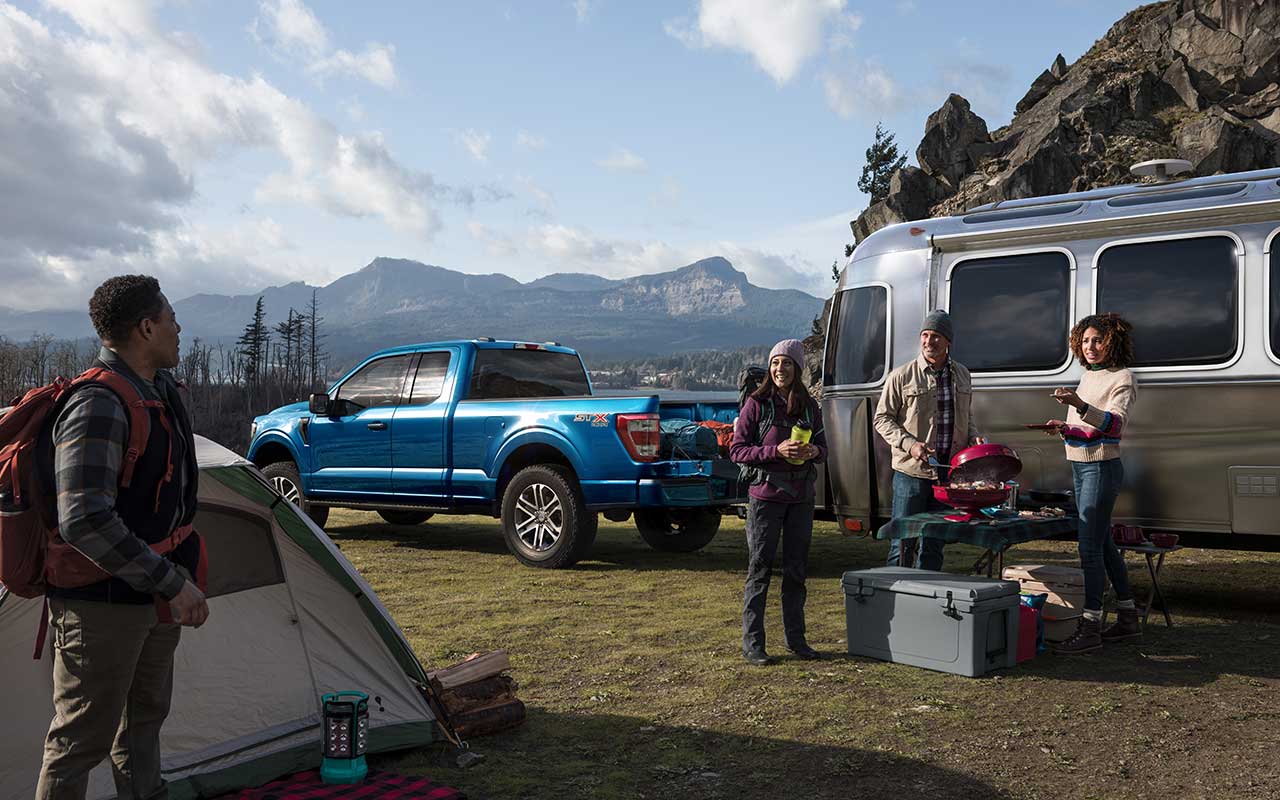
Photo courtesy Ford
Hitch Up the Easy Way With Our Travel Trailer Towing Guide
Some 56 million Americans are expected to hit the highways, byways, and backroads this summer with a recreational vehicle, according to the latest RV Industry Association (RVIA) surveys. Another 10 million RVers will join them in 2022. About 1-in-5 of those hitting the road will be hitching up and towing a travel trailer—everything from teardrops to tent trailers and travel trailers to toy haulers as individuals, families, and friends head out to enjoy all the freedom and adventure our great country offers.
For more than 110 years, automobile owners have been towing recreational vehicles so they can explore America. Towing a travel trailer is part of adventure-seekers’ DNA, and we’ve been doing it as long as automobiles have been around.
The urge to explore at one’s own pace with a travel trailer in tow was hugely popular in the 1950s and ‘60s. Today, that popularity in RVing is once again thriving as Americans look for ways to travel the nation comfortably and safely.
The safest way to travel
“More and more Americans are ready to travel this summer, and 56 million of them are planning to go RVing in an RV they rent, own, or borrow,” said Craig Kirby, President and CEO of RVIA. “Even with other forms of travel returning, the desire to use an RV to get outdoors and experience an active outdoor lifestyle is stronger than ever. RVing has been cemented as a mainstream travel option that is here to stay.”
The appeal of exploring the country while towing a travel trailer appeals to all age groups and interests, too. The popularity of RVing has even attracted media attention from the Wall Street Journal, which ran “The Safest Way To Travel This Summer” in a May 2020 issue.
This surge in the popularity of RVing comes to light when you try to book reservations for an RV campground space at county, state, and national parks. You can also see it on the road; the number of cars, pickups, vans, SUVs, and crossovers towing travel trailers has never been greater.
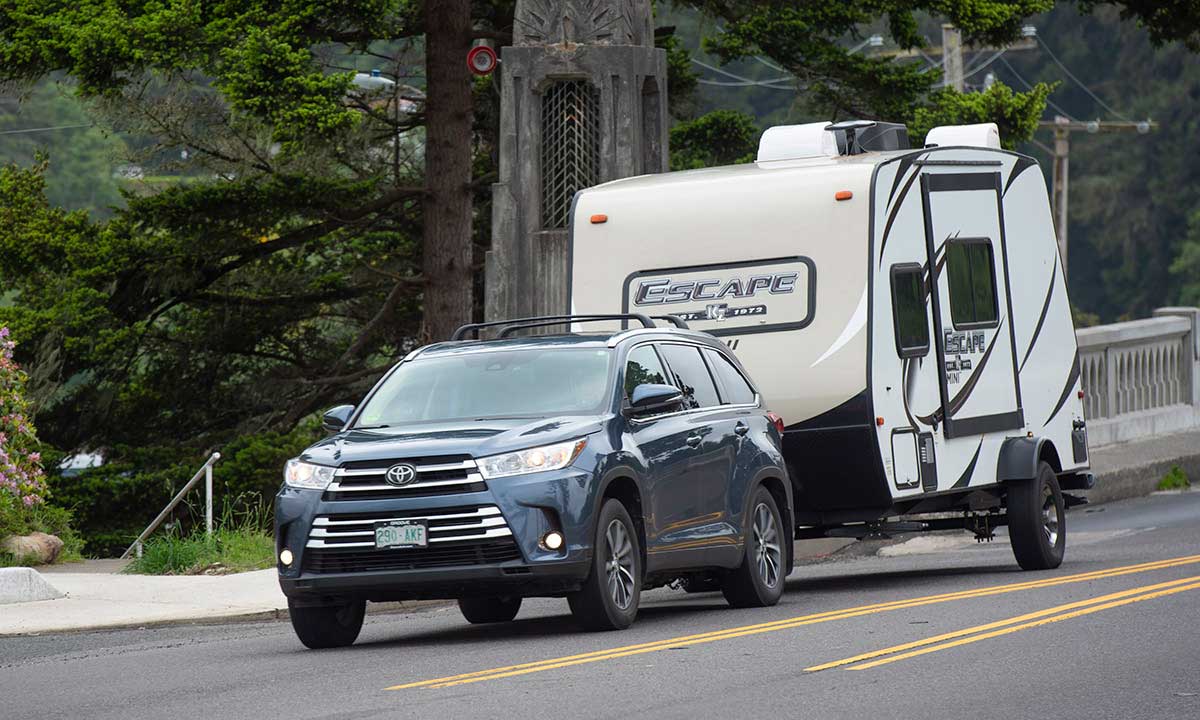
Americans hitting the road to vacation with an RV trailer in tow is at an all-time high. Make sure your travel trailer is the proper Gross Vehicle Weight Rating (GVWR) and doesn’t exceed the maximum tow rating of the vehicle towing it.
Safety concerns towing a travel trailer
From Gen Z to Boomers, RVing via a travel trailer of any type offers freedom and a sense of self-sufficiency. It’s both a practical and comfortable form of lodging. You can disconnect your tow vehicle and have a base camp to explore the area around you.
But towing a travel trailer can bring some unexpected drama and safety concerns for millions of first-time RVers. Trailers add weight to the back of the tow vehicle, and that added weight changes the handling dynamics and braking of the tow vehicle. That’s why you need to make sure your trailer and tow vehicle are properly matched.
This guide explains the basics of towing a travel trailer so your RVing experience is easier, safer, and more enjoyable.
The basics of towing a travel trailer
Towing a travel trailer consists of three components: the vehicle, the hitch, and the RV.
Within those components are variations based on the vehicle’s towing capacity, the weight of the RV, the hitch setup, and towing-related accessories to tie everything together safely.
In this towing guide, we are specifically talking about “tow-behind” or “bumper-pull” RV trailers that attach to the hitch ball on a hitch mounted under the bumper of a pickup, SUV, crossover SUV, or car, not a 5th wheel or gooseneck hitch that mounts in the bed of a pickup truck.
You can easily avoid drama and stress by properly matching the tow vehicle, hitch, and travel trailer. But get one of those wrong, and you have a recipe for disaster.
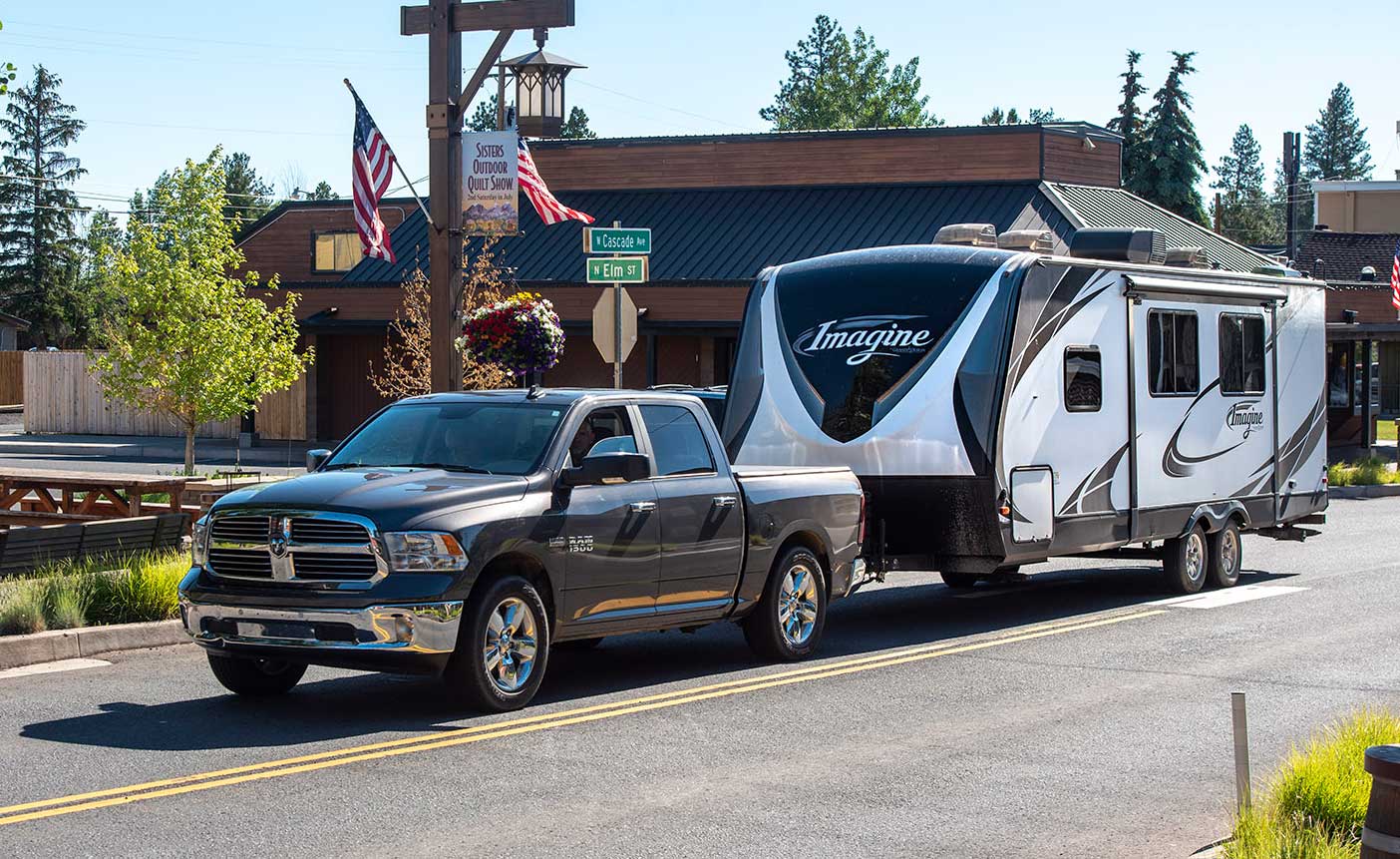
The best vehicle for towing any trailer is the one that fits both your personal needs and requirements while the trailer falls within the limitations set by the vehicle’s manufacturer.
What is the best vehicle for towing a travel trailer?
So, let’s begin with the tow vehicle. One question I get a lot from first-time RVers is, “What’s the best vehicle for towing a travel trailer?” The answer is, “It all depends.”
It all depends on what type of trailer you want to tow, whether you intend to tow with a vehicle you currently own, or maybe you have neither a tow vehicle nor a travel trailer and want to get both.
The most important aspect of towing a travel trailer is making sure the vehicle is up to the task of towing the trailer you plan on attaching to the hitch ball.
Here’s the deal when it comes to tow vehicles: The vehicle manufacturer determines how big (heavy) a trailer the vehicle can safely tow—not you. From a legal standpoint, that’s it, but I’ll explain more later in this RV trailer towing guide.
RV trailer numbers you need to know
There are two important weight-related factors when it comes to RV trailers: GVWR (Gross Vehicle Weight Rating) and tongue weight (TW).
GVWR is the safe maximum weight of the trailer when it’s loaded for camping with water, fuel, supplies, and cargo. The TW is how much downforce the loaded trailer places on the hitch.
Both numbers are displayed on the metal Federal Certification / VIN ID tag located on the front left side of a travel trailer. You can also find the specifications listed on the trailer manufacturer’s website.
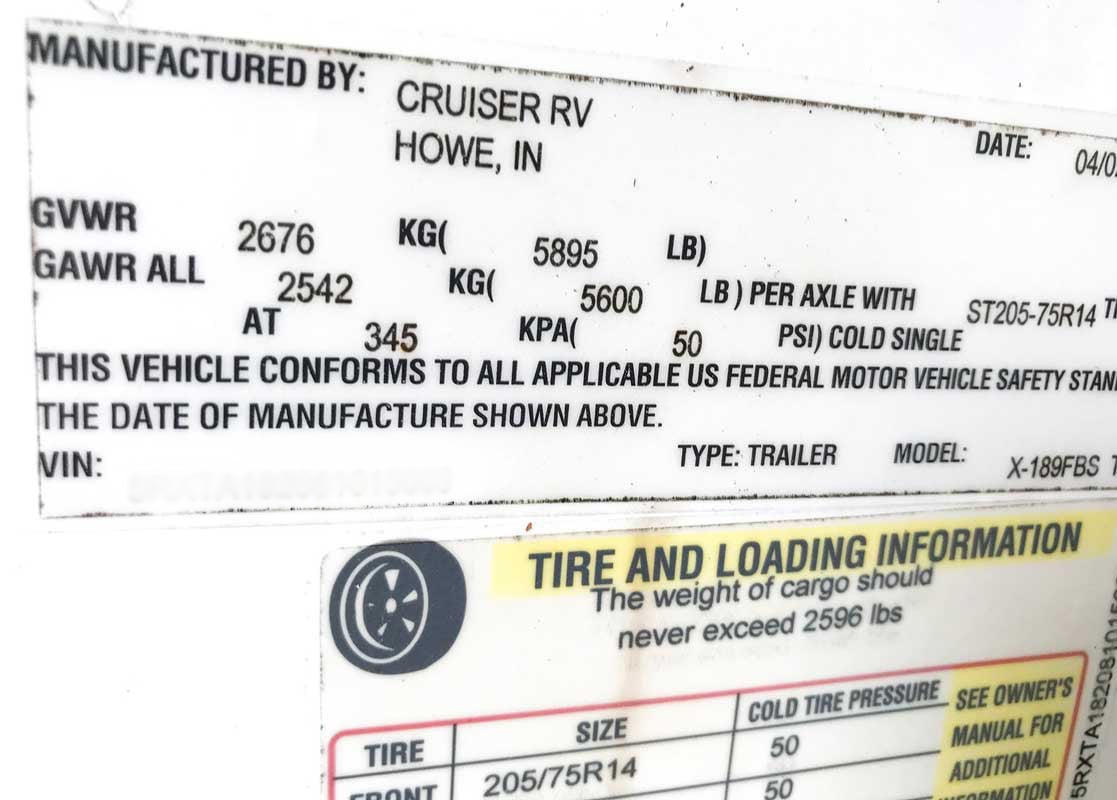
Every RV trailer has an ID/VIN decal or metal tag somewhere on the left front. It shows the trailer’s GVWR, which is the maximum it can weigh fully loaded. This is a critical number to know when matching a tow vehicle to a trailer. The trailer’s GVWR should never exceed the tow vehicle’s maximum tow rating.
Concentrate on those two weights, not the RV’s bells and whistles or nice furnishings. Those two numbers set the basis for choosing the vehicle best suited for towing a travel trailer.
Tongue weight of RV trailers, sometimes referred to as “hitch weight,” will be typically between 10- and 15-percent of the trailer’s GVWR.
For example, a 32-foot trailer like the Forest River Aurora 28BHS, weighing 7,600 pounds GVWR, has a TW of 730 pounds, while the 32-foot Grand Design Imagine 2800BH has a GVWR of 7,995 pounds and a hitch weight of only 604 pounds.
So, do your research. RV trailer weights can vary widely by brand, type, and size. That’s why it’s important to narrow down these numbers to the specific trailer you plan to tow and then make sure those weights match your vehicle’s towing limitations.
Payload calculator
A website called Keep Your Daydream Today does a great job of explaining all the weight-related towing nuances, and the site has a nice payload calculator that can be downloaded to figure out what you can safely tow per the vehicle manufacturer’s listed tow ratings.
How big of an RV trailer can my vehicle tow?
Now that you know the trailer’s GVWR and TW, it’s time to focus on the tow vehicle. Towing a travel trailer from your home to a campground begins with dropping the trailer tongue on a hitch ball. But the most critical aspect of safely getting from Point A to Point B is having the right vehicle for towing.
Your tow vehicle needs to have the power to pull the trailer up hills and maintain reasonable speeds over the open road. More importantly, the tow vehicle has to be properly equipped for towing, per the vehicle manufacturer’s guidelines, and have the factory tow rating capacity to handle the load it’s towing.
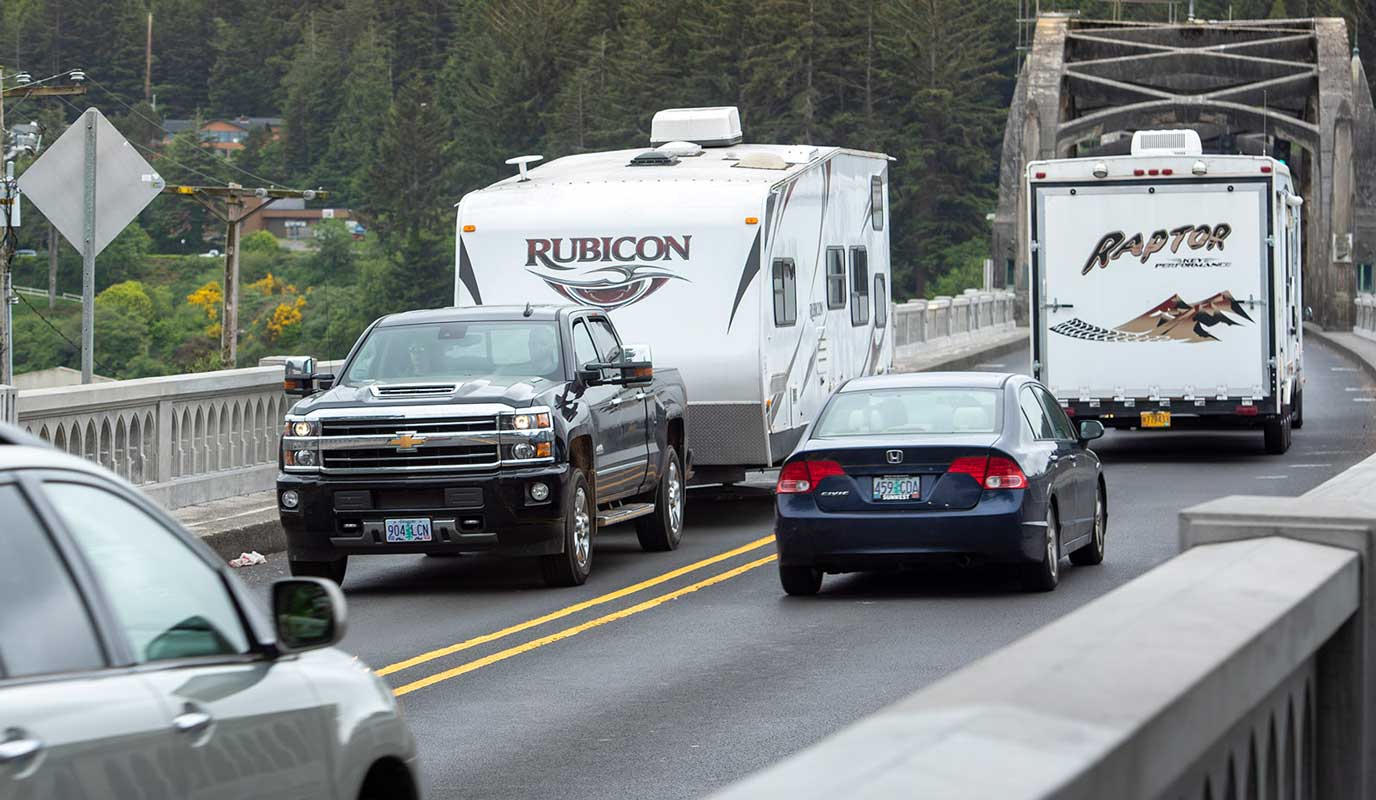
Having the right tow vehicle for the trailer takes all the drama out of the RVing experience and maximizes the safety factor for others on the road.
The only one who can set the limit on how much weight any vehicle can tow is the vehicle manufacturer.
To find your tow vehicle’s maximum trailer towing capacity, and what it needs to be properly equipped per the vehicle manufacturer’s specifications, dive into the towing/trailering section of the owner’s manual. There you’ll find the bare-bones information.
RV tow rating information
But what you really want is the detailed tow rating information. For that, you’ll have to dig deeper. The information is usually on the vehicle manufacturer’s fleet/commercial website under a heading like “RV & Trailer Towing Guide.”
When matching a trailer to a tow vehicle, a good rule-of-thumb is to keep the trailer’s GVWR at less than 75 percent of the tow vehicle’s trailer towing capacity.
So, if the tow vehicle is rated for a maximum of 6,000 pounds, the chosen trailer should have a GVWR of 4,500 pounds or less. Likewise, if the tow vehicle is rated to tow 10,000 pounds, a good trailer weight is 7,500 pounds or less.
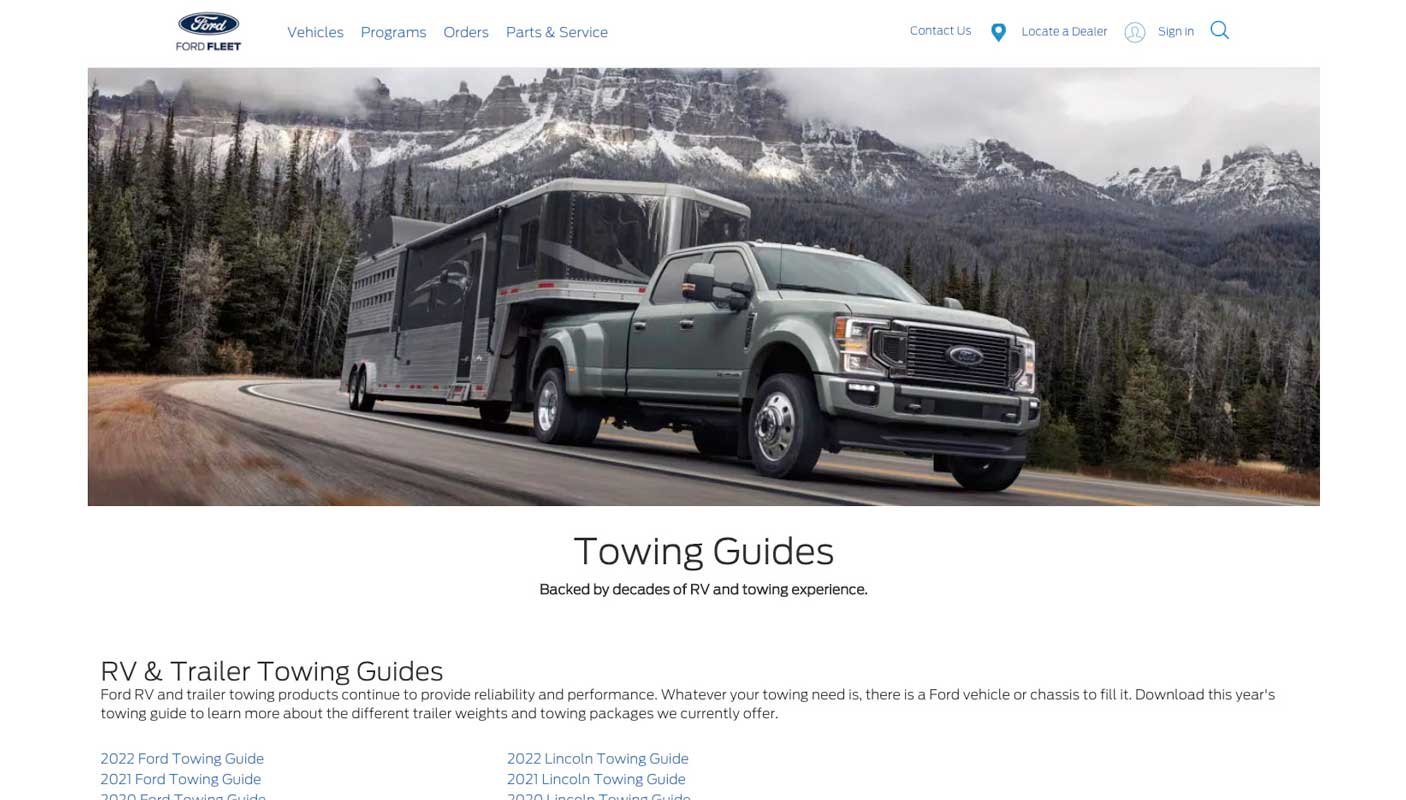
You can find detailed trailer towing information on the vehicle manufacturer’s fleet/commercial website under a heading like “RV and Trailer Towing Guide,” “Towing Guides,” or “Trailering Guide.”
Where to find pickup truck manufacturer trailer towing ratings
To make tracking down trailer tow ratings of the Big Three pickup manufacturers easy, here are those website links:
- Chevrolet: www.gmfleet.com/Guides
- Ford: www.fleet.ford.com/towing-guides
- GMC: www.gmfleet.com/GMC Trailering Guide
- Ram Truck: www.fcausfleet.com/ramtrucks/towing-guide
It’s easy to find the trailer towing limits for cars, SUVs, and crossover SUVs. Pickups are a whole different story.
Pickup truck ratings for towing a travel trailer vary by year, make, model, cab configuration, transmission, and axle ratio. They can also vary related to the type of hitch setup, whether “conventional weight-carrying” (towing-on-the-ball) or using a weight-distributing hitch system. So read the numbers and annotated information carefully.
Vehicle’s trailer tow ratings can’t be changed
As you review trailer tow ratings, you’ll see that just because a vehicle has a hitch doesn’t mean it can tow whatever is attached to the hitch ball. Every vehicle that rolls off the assembly line has a towing limitation, just as it has a unique VIN.
Once a vehicle leaves the manufacturing assembly line, its tow ratings and cargo-carrying capacities are set in stone—just like the VIN. Those ratings could have higher/lower capacities, depending on the engine and transmission package, axle ratio, and other options available on that particular model vehicle. This is especially true of pickup trucks.
Even though installing aftermarket products like air bags and anti-sway bars can improve the ride and handling when towing a travel trailer, such modifications do not change that particular tow vehicle’s limitations as set by its manufacturer.
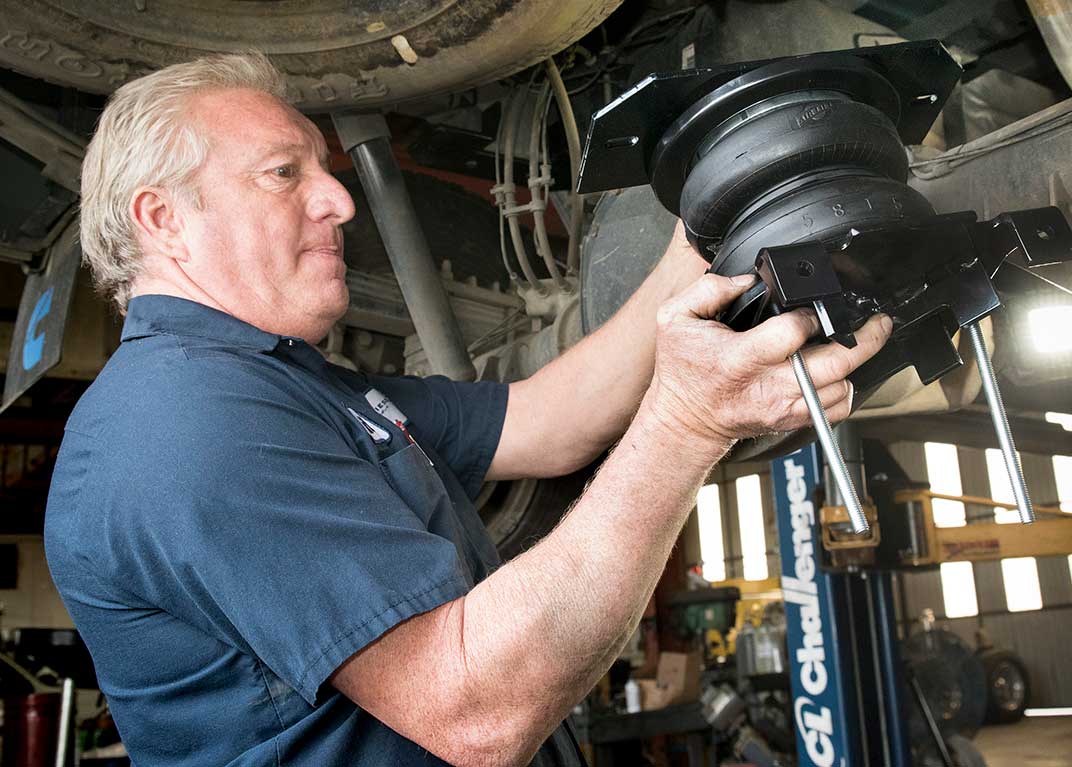
Installing overload springs, anti-sway bars, air helper springs, a heavier-duty hitch, or making other vehicle suspension, drivetrain, or engine modifications does NOT change the vehicle’s tow rating or load capacity. Those ratings are set by the vehicle manufacturer when the vehicle is built.
Why are vehicle manufacturer trailer towing ratings important?
Why is it important to know the trailer towing limits of your vehicle? Safety. Warranty. Liability.
Vehicle manufacturers set vehicle tow ratings and load capacities with safety, warranty, and liability at the forefront. They do so using special test procedures specified under SAE J2807, which is a strict vehicle manufacturing safety standard focused on keeping the driver and occupants reasonably safe when towing trailers.
At the same time, SAE J2807 testing protocols allow the vehicle manufacturer to set a comfortable weight limit for the vehicle to function reliably through the warranty period when used for such towing and cargo-carrying tasks.
Among the battery of tests within SAE J2807 are emergency accident-avoidance and vehicle control tests with a loaded trailer in tow. If the vehicle being tested doesn’t pass these tests in a manner deemed safe by the vehicle engineering team, then the trailered weight is reduced and the vehicle re-tested until it meets the safety standards. When it meets the safe standard, that’s the maximum trailer towing capacity for that particular vehicle.
Towing a travel trailer that’s heavier than the vehicle is rated for towing, or not having the tow vehicle properly equipped, can put the burden of liability on you if you’re in an accident. Your insurance company could very well deny coverage because under the law, you, the driver, are considered negligent.
Trailer tow ratings can be confusing. But they are very important from a safety and vehicle handling standpoint.
Real-world lessons in trailer weight ratings
A neighbor recently joined the millions of Americans towing a travel trailer on his family’s first RV adventure. He hitched a beautiful Forest River 2021 rPod 190 travel trailer to the hitch of his 2017 Lexus RX 350 AWD. His first weekend on the road towing the trailer “scared him to death” because of trailer sway. He couldn’t understand why his Lexus handled so poorly when it was “rated” to tow 3,500 pounds—according to the trailer salesperson—and the trailer only weighed 2,900 pounds.
We looked at the numbers. He had two issues. First, the “dry weight” of the rPod was 2,900 pounds, but the GVWR was 3,800 pounds. Second, his Lexus was rated to tow 3,500 pounds only if equipped with “a sway control device with sufficient capacity” per the owner’s manual. Otherwise, the trailer towing capacity was limited to 2,000 pounds.
So, he installed a Blue Ox SwayPro 350 weight distribution hitch and made sure the trailer’s GVWR didn’t exceed 3,500 pounds.
He and his wife have spent anywhere from 3 to 5 days traveling around the Pacific Northwest at least twice a month, loving the RV life! For now, the Lexus and rPod are a happy match for their lifestyle.

Even though a salesperson says the vehicle you are buying is “perfectly capable” of towing such-and-such trailer, have the trailer’s GVWR number memorized, and then have the salesperson show you the maximum towing specs for the specific vehicle. In pickups, the difference in axle ratios alone can make a 2,000-pound or greater difference in a tow rating. In smaller vehicles, the same can be true for different engines.
Don’t rely on salespeople for accurate towing info
Another friend bought a 2021 Ram 1500 Laramie 4×4 Quad Cab and an equally nice 26-foot Backcountry Mountain TRX trailer so the family of four could enjoy the outdoor lifestyle during summer and fall. The salesperson at the Ram dealer said the Hemi-powered 4×4 could tow as much as 12,750 pounds, so no problem towing the 9,995-pound Outdoors RV camper.
But what he found out later when looking up the maximum trailer tow ratings in the Ram towing guide was that his particular pickup, with the standard 3.21 axle ratio, was limited to just 8,330 pounds. Fortunately, he persuaded the dealer to swap his new pickup for an identical one that was equipped with the “premium” 3.92 axle ratio, which was rated to tow 11,430 pounds—a much better match to the trailer and much safer for his family.
To that end, you must go back to the basics of weight when it comes to how much your vehicle can tow. You need to know the GVWR of the trailer and the maximum trailer capacity of your specific tow vehicle.
If the trailer’s GVWR is more than the trailer tow rating of your tow vehicle, find a lighter trailer or a tow vehicle with a higher trailer towing capacity.
A good rule-of-thumb in choosing a trailer is its GVWR be no more than two-thirds the max trailer tow rating of the vehicle. This gives you a margin of error on the safe side. Your tow vehicle must also be properly equipped as specified by its manufacturer.
What is the best 4X4 for off-grid RVing?
So what’s the best 4×4 vehicle for towing trailers when camping off the grid and exploring roads less traveled? Most people think the obvious answer is one of the many Jeep models, such as the iconic Wrangler Unlimited Rubicon or Grand Cherokee. They’re partially correct.
Jeep Models
Setting fuel economy and price aside, the Jeep Rubicon 392 is king, setting the highest bar among the Jeep line when it comes to overall backcountry and off-road performance. Its V8 power, technology, and agility are amazing.
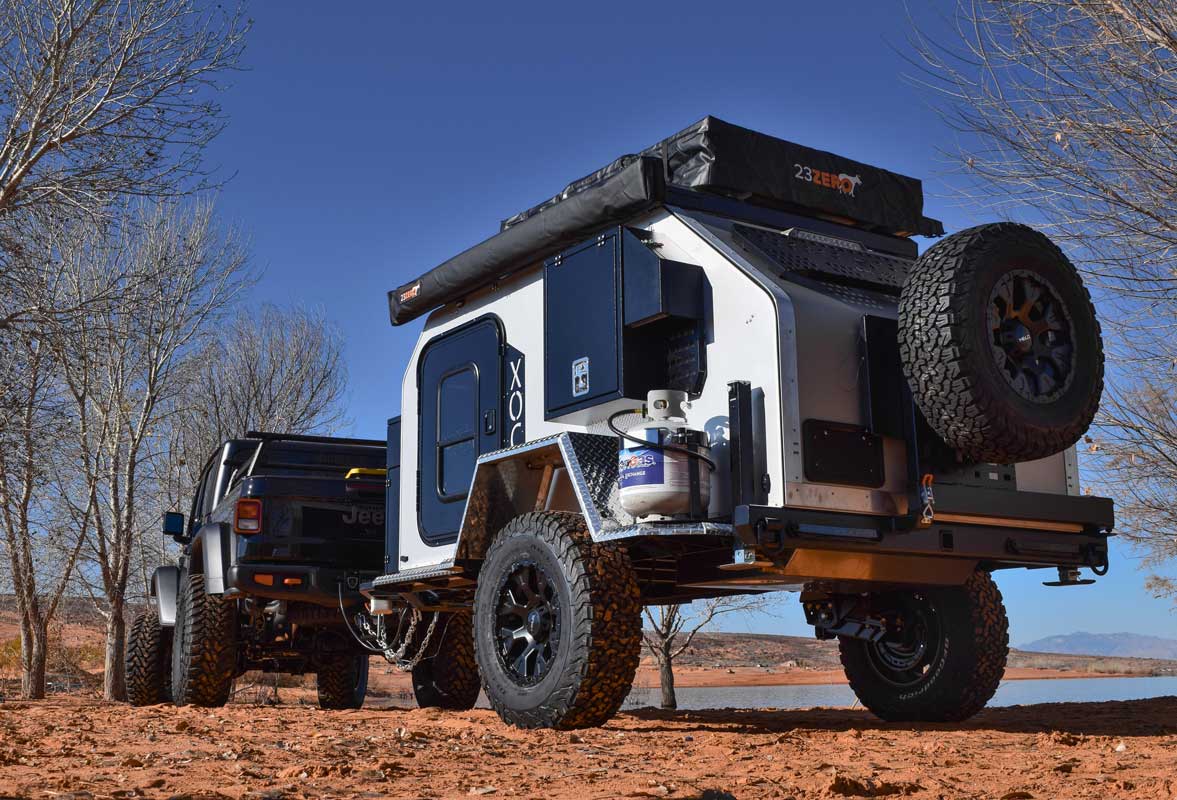
Jeeps are the icon for off-pavement/off-road travel. But the soft, pliant suspension takes away some of their towing ability, limiting most models to towing trailers less than 3,500 pounds. Off-road trailer manufacturers such as Vorsheer, which makes the 2,600-pound (GVWR) XOC, build their trailers to accommodate these tow ratings. Photo courtesy Vorsheer Mfg
But the Jeep Wrangler’s soft, pliant suspension, across all models, is also its downfall when it comes to tow ratings. They are among the lowest in this class of SUV, with a maximum towing capacity of just 3,500 pounds for the 6.4L V8-powered Rubicon 392 to as little as 2,000 pounds for the base model two-door Wrangler Sport with the 3.6L V6.

Jeep’s Grand Cherokee is an excellent tow vehicle for those who do a lot of highway RVing and backcountry travel with “light off-roading.” Some models can tow up to 7,650 pounds.
The Jeep Grand Cherokee has higher tow ratings ranging from 4,000 to 7,200 pounds (Hemi V8-powered SRT). But the Jeep Gladiator pickup is the best choice with a trailer towing capacity of up to 7,650 pounds, depending, of course, on the model and axle ratio.
Ford Bronco
A new contender when it comes to the best 4×4 for RVing off-grid is the latest iteration of the iconic Ford Bronco. Ford’s new SUV leads the pack for four-wheeling in overall performance, with excellent fuel economy, suspension travel, and traction capabilities.
Broncos equipped with the 2.7L EcoBoost V6 and 10-speed automatic combo are ideal for towing. The trade-off for the Ford Bronco’s off-road prowess is a limited trailering capacity of up to 3,500 pounds when equipped with the optional Class II Trailer Tow Package.
Ram 1500
If money isn’t an option and you want the very best 4×4 for off-grid travel and towing RV trailers, the 702hp Ram 1500 TRX, with a tow rating of 8,100 pounds, wins. Hands-down. It’s won both Four Wheeler and MotorTrend magazine’s Truck of the Year and several other prestigious automotive pickup awards this year.
Hitch types and hitch capacities
The term “properly equipped” means the vehicle has the factory towing package, which can vary from vehicle to vehicle and from manufacturer to manufacturer. But it always includes a factory-installed receiver hitch and wiring to connect between the tow vehicle and the trailer.
Properly equipped also means using the proper hitch type for the weight of the trailer. There are two hitch types for towing a trailer using a receiver-type hitch: weight carrying and weight distributing.
Attaching the trailer to the hitch ball bolted on the shank that comes out of the hitch is called “weight carrying” because the full load of the trailer’s tongue weight is carried by the hitch assembly.
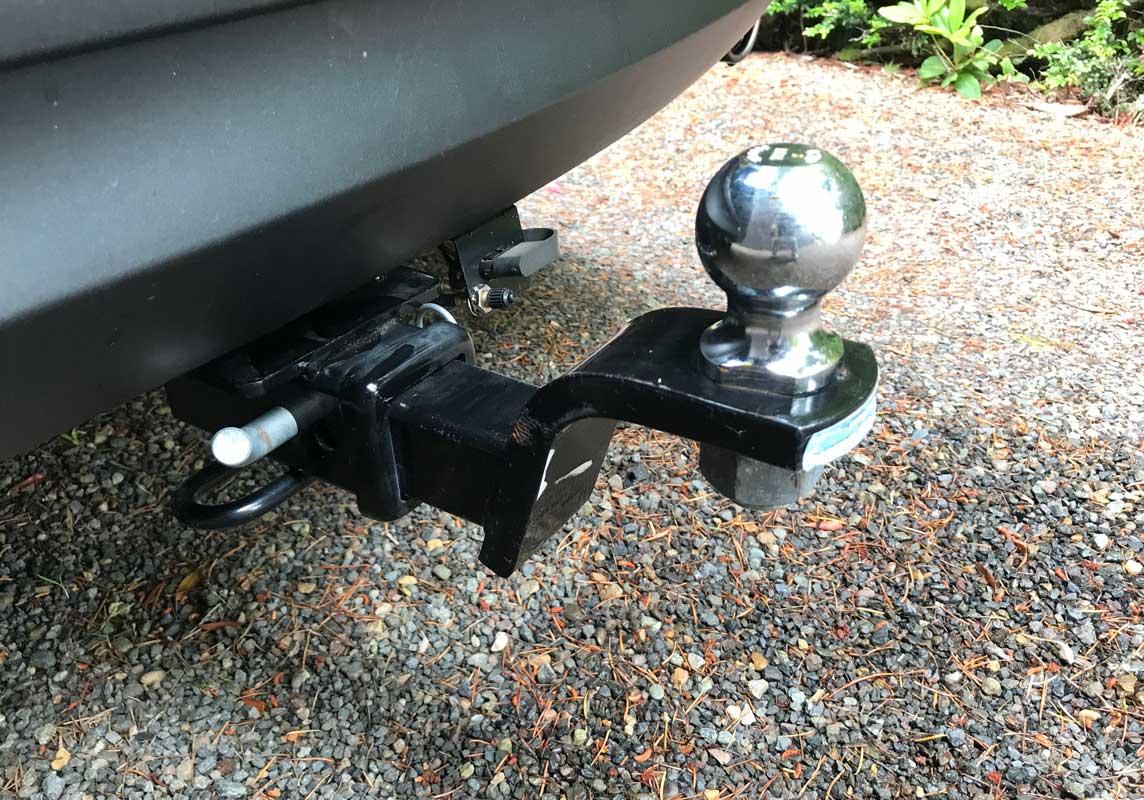
This is a typical “weight-carrying” hitch setup that comes from the factory. It accommodates a “shank” with a trailer ball mount. The load capacity of a hitch can be found on the hitch manual’s decal—the same with the shank. The hitch ball capacity is imprinted on the top of the ball.
The towing capacity of the hitch is determined by the hitch manufacturer, and the maximum load/towing capacities are listed on the hitch, the hitch shank, and on top of the hitch ball. Hitches come in five classifications depending on the size of the opening for the receiver (shank) and load capacity.
The typical factory hitch on cars, crossovers, smaller SUVs is Class I or II.
Midsize pickups, SUVs, and vans generally come with a Class III hitch.
Full-size pickups usually have a Class IV hitch, while some 1-ton diesels use a Class V hitch.
Hitch classes and Gross Trailer Weight
| Class | Basic Use | Size of Opening | Gross Trailer Weight (GTW) | Tongue Weight Capacity |
| I | Light-Duty | 1.25” | 2,000 lbs. | 200 lbs. |
| II | Moderate-Duty | 1.25” | 3,500 lbs. | 350 lbs. |
| III | Versatile/Mix | 2” | 3,500–6,000 lbs. | 350-600 lbs. |
| IV | Heavy-Duty | 2” | 10,000–12,000 lbs. | 1,000–1,200 lbs. |
| V | Heaviest-Duty | 2.5” | 16,000–20,000 lbs. | 1,600–2,000 lbs. |
NOTE: Changing the size of the hitch to one with a higher capacity DOES NOT change your vehicle’s tow rating.
Understanding hitch balls and capacity
The most important connection point between the tow vehicle and the trailer is the shiny round thing sticking up from under the bumper—the hitch ball. You’ll have a big problem if the ball isn’t the correct size to fit the trailer coupler, or the ball isn’t installed on the shank (mount) with the correct amount of torque on the nut.
Standard RV trailer hitch balls come in three different diameters: 1-7/8″, 2”, and 2-5/16″, while shank sizes varying from ¾” to 3″ depending on the hitch capacity. The smaller 1-7/8″ hitch balls have a towing capacity of up to 3,500 pounds and are typically found on cars, smaller SUVs, minivans, and crossovers.
Hitches equipped with 2″ tow balls are rated for 8,000 pounds and are typical of that used on smaller travel trailers and overlanding/adventure-style off-road trailers. The larger 2-5/16″ hitch balls are rated from 12,500 pounds to 21,000 pounds and are common on RV trailers that weigh more than 8,000 pounds.
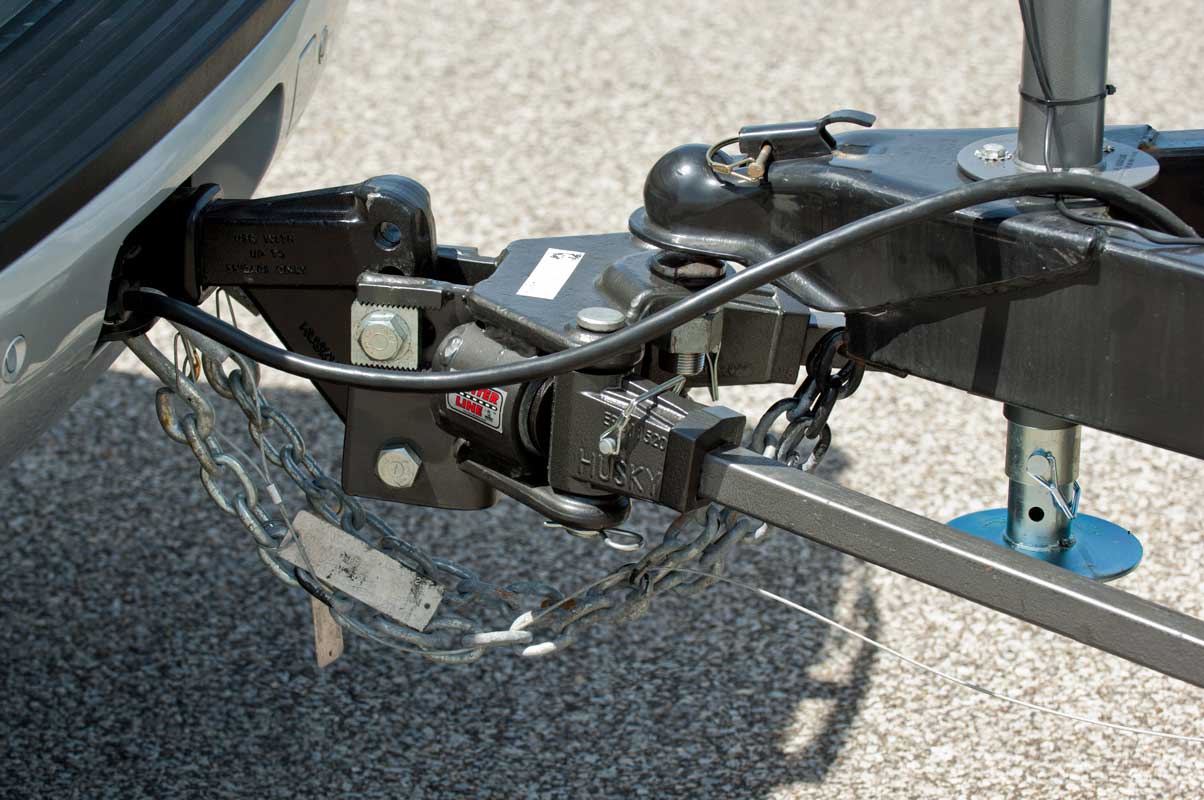
A typical weight-distribution (WD) hitch has two “spring bars” that extend from the hitch head to the trailer. The bars act like wheelbarrow handles, so some of the weight of the trailer on the hitch can be shifted fore and aft to better balance the tow vehicle/trailer combo. A WD hitch also greatly reduces trailer sway.
How do weight distribution hitches work?
A weight distributing hitch, or weight distribution hitch, uses a special head with provisions for attaching one or two long arms that attach to the trailer frame that can be adjusted to transfer some of that tongue weight fore and aft so the tow vehicle is better balanced.
The typical WD hitch also incorporates an anti-sway device or design for better trailer control.
“The weight distribution feature will transfer some of the weight to the front axle, as well as some being transferred back to the trailer’s axle(s)” explains Josh Jones, a customer service rep at Progress Manufacturing, makers of the Equl-i-zer Hitch and Fastway trailer towing components.
“Basically, 1/3 of the tongue weight is transferred from your tow vehicle back to the trailer, and the remaining 2/3 is evenly distributed on the front and rear axles of your truck. This gives all four tires equal contact with the road, improving steering and braking, and the hitch’s built-in sway control eliminates sway before it starts so you have a smoother, more enjoyable towing experience.”
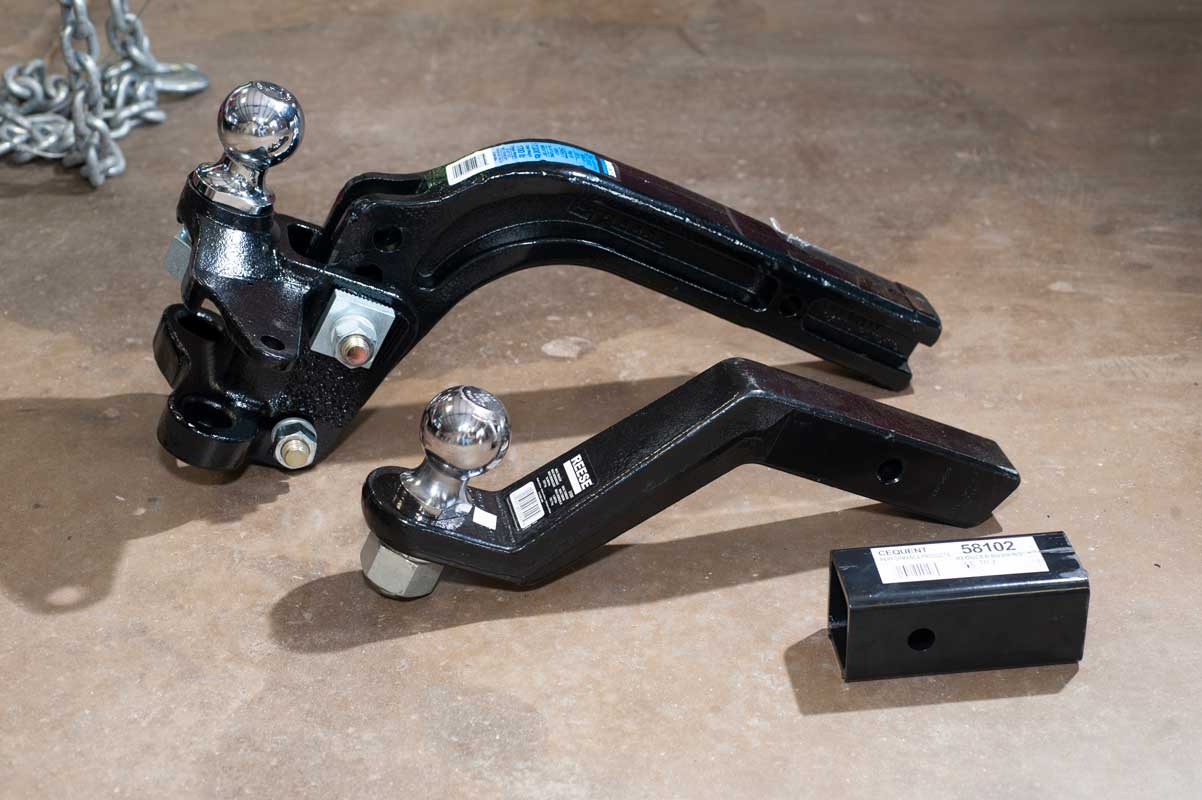
Both weight-distributing (top) and standard hitches have maximum trailer towing ratings. Using a reducer sleeve (bottom) to step down from 2.5” or 3” hitch receivers to 2” also reduces trailer towing capacity.
That’s why the “weigh-carrying” tow capacities of a vehicle, especially full-size pickups, vans, and SUVs, are usually considerably less than a “weight-distributing” setup because more weight is put on the rear axle when one is just towing on the ball.
These dual-capacity tow ratings really apply to pre-2018 and older heavy-duty pickups with some max trailer towing limits of 5,000 pounds towing-on-the ball unless a weight-distributing hitch is used. Also, using the 2″ adapter sleeve in newer pickups’ 2.5″ receiver hitches significantly reduces both the weight-carrying tow limit and maximum tongue weight.
The Best 2022 Pickups For Towing Trailers With GVWR Under 5,000 Pounds
| Chevy Colorado/GMC Canyon | with 3.6L V6 or 2.8L Duramax Turbodiesel |
| Chevy Silverado/GMC Sierra 1500 | with 3.0L I-6 Duramax TD or 5.3L V8 |
| Ford F-150 | with 3.5L EcoBoost V6 or 3.5L PowerBoost Hybrid V6 |
| Ford Ranger | with 2.3L EcoBoost |
| Nissan Frontier | with 3.8L V6 |
| Ram 1500 | with 3.6L eTorque V6 or 3.0L EcoDiesel |
| Toyota Tacoma | with 3.5L V6 |
| Toyota Tundra | with 5.7L V8 |
Brake requirements for RV travel trailers
Attaching a trailer to your tow vehicle places an additional load on its braking system. That means the heavier the trailer, the less responsive the brakes and the longer it takes to stop the vehicle. That’s why most state motor vehicle laws require trailers over a certain gross weight must have their own trailer braking system.
Some state trailer laws require a braking system on trailers with a GVW of 1,500, some 3,000 pounds, and some 6,000 pounds GVW. Other states require the tow vehicle/trailer combo must stop within a certain distance from a designated speed, or the tow vehicle be able to hold the trailer while stopped on a “hill of any grade under all conditions.”
Thankfully the RV trailer manufacturers make the braking aspect of towing a travel trailer easy by equipping their trailers, even the lighter off-road/overlanding camp trailers, with electric brakes on trailers that weigh more than 1,500 pounds. This way, the trailer can be sold in any state and meet the legal brake requirements.
As for trailer brakes, the typical RV trailer has electric-actuated brakes along with a “breakaway” system in the event the trailer decides to go for a little side trip on its own. (Breakaway systems are required on trailers with a GVW greater than 3,000 pounds.)
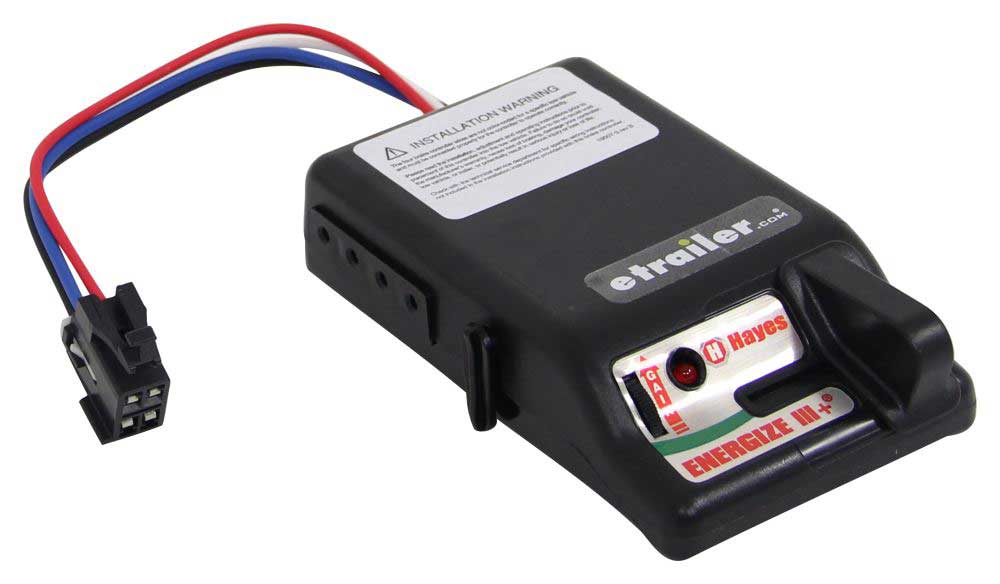
Aftermarket electric brake controllers send electronic signals to the trailer brakes when the driver hits the tow vehicle’s brake pedal. There are lots of types of controllers, and most allow the driver to manually apply the trailer brakes via a dash-mounted controller if needed. Photo courtesy eTrailer.com
How do RV trailer brakes work?
Electric-actuated RV trailer brakes on bumper-pull can be either drum or disc, much like those that stop your tow vehicle. The braking is applied when an electrical signal is transmitted from the brake pedal to a separate device in the vehicle called a brake controller, which then signals and activates the trailer’s brakes.
In an electric drum brake system, the braking signal goes to an electromagnetic actuator inside the brake drum that pushes the brake linings into the drum. On an electric-over-hydraulic disc braking system, the signal from the controller activates a hydraulic pump that pushes fluid in the brake lines to the calipers that engage the brake rotor.
Some of the newest pickups and SUVs have built-in brake controllers, while older pickups and most cars, crossovers, and SUVs will need an aftermarket brake controller unit installed. Either way, it’ll be up to you to make the proper brake controller adjustments per that particular brake controller’s instructions.
Both braking systems require the proper trailer plug, the correct trailer wiring setup in the tow vehicle, and a charged battery in the trailer to operate safely. Part of most vehicle manufacturers’ “Towing Package” includes such wiring and plug for the trailer wiring harness.
Typical travel trailer weights
When you shop for RV travel trailers, you’ll see a wide range in gross vehicle weight ratings (GVWR), even in the tiny trailers and off-road trailers. For instance, the typical teardrop trailer comes in between 1,500 and 2,500 pounds, with the more robust overlanding off-road trailers coming in with a GVWR between 2,500 to 4,500 pounds. Pop-up tent and hard-sided campers generally have GVWRs between 2,000–4,000 pounds.
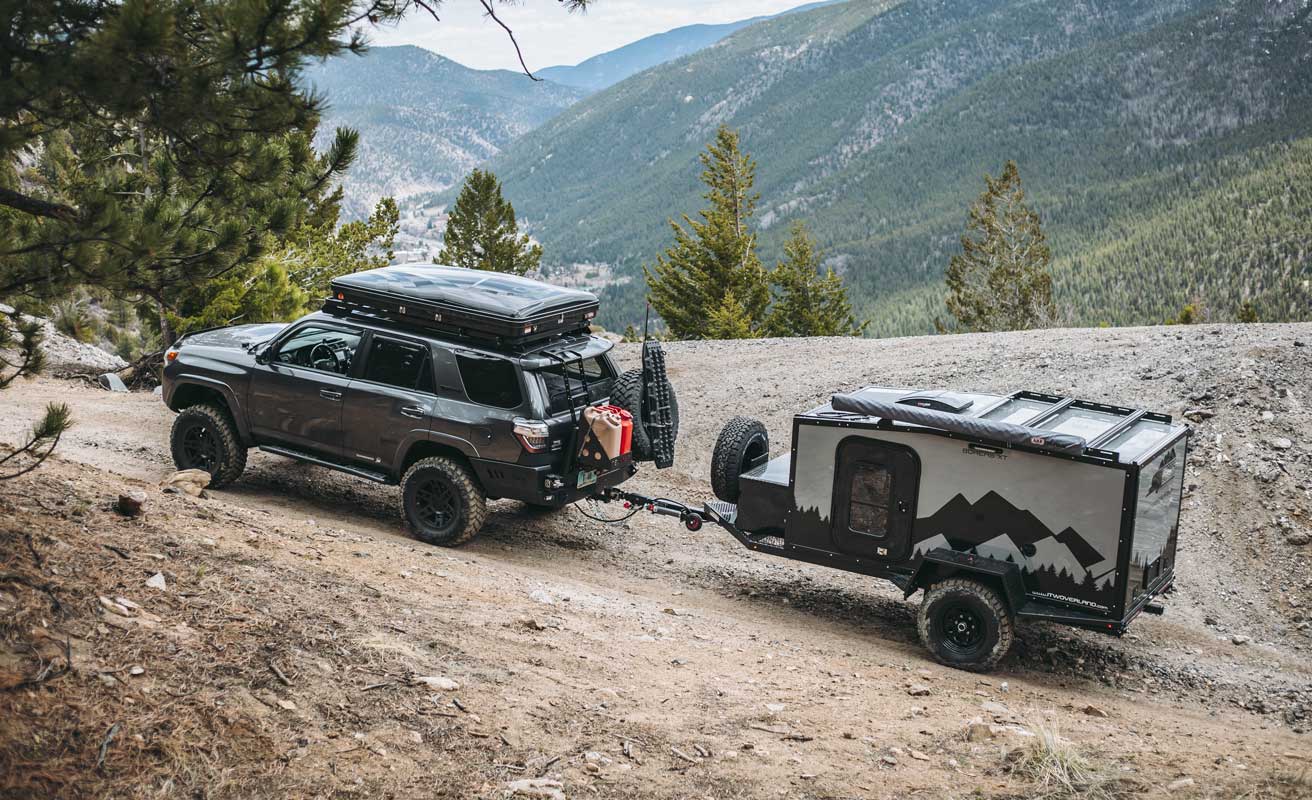
RV trailers are available to fit just about any lifestyle. They also vary in weight, so it’s easy to find the perfect travel trailer to fit your tow vehicle. Some adventuresome RVers—of an estimated 10 million taking vacations with a trailer in tow—will be doing so on roads less traveled. Photo courtesy Boreas Campers
More traditional bumper-pull RV trailers have an average GVWR range related to their length, design (camper or toy hauler), and number of slideouts. Midsize RV trailers in the 23- to 28-foot range have a maximum loaded weight between 6,000 and 8,000 pounds.
Start shopping around for the 30-foot-plus bumper-pull trailers and the GVWRs can top 10,000 pounds, which is nearing the upper limit for most full-size pickups and SUVs towing with a weight-distributing hitch.
Popular trailers for towing and average weights
While there are hundreds of travel trailer brand and specification combinations we could list, we’ll focus on some well-known RVs to give you a sense of what to look for when shopping for a trailer to tow:
| Lance Camper 1685 | 16’6 | 5,500 lbs. |
| BRX X2 (off-road/tent) | 16’9” | 3,500 lbs. |
| Escape 17A | 17’8” | 4,000 lbs. |
| NuCamp TAB 400 (teardrop) | 18’3” | 3,900 lbs. |
| Starcraft Autumn Ridge 172FB | 19’ | 3,750 lbs. |
| Black Series HQ12 (off-road camper) | 19’6” | 6,750 lbs. |
| Sylvansport VAST | 21’6” | 4250 lbs. |
| Keystone Bullet Crossfire 1900RD | 22’ | 4,700 lbs. |
| Forest River Flagstaff Micro Lite 21 DS | 22’ | 6,800 lbs. |
| Winnebago Hike H210RB | 25’ | 6,000 lbs. |
| Airstream Flying Cloud | 28’ | 7,600 lbs. |
| Northwoods Arctic Fox | 29’ | 10,000 lbs. |
| Jayco Jay Flight Octane 255 (toy hauler) | 29’ | 9,500 lbs. |
| Cruiser RV MPG (ultra-light) | 30’ | 7,600 lbs. |
| Grand Design Imagine | 32’ | 8,500 lbs. |
| Highland Ridge Light | 35’ | 9,990 lbs. |
Where do electric pickups fit in with towing RV trailers?
Electric vehicles, aka EVs, are slowly making their way into the automotive market but still only make up less than 2 percent of the new car market in the U.S., according to Pew Research and other market watchers.
EVs, whether car, SUV, crossover, or pickup, are excellent modes of transportation for city and urban settings. Not so much so in rural America, where the availability of designated plug-in sites is few and far between. EV vehicles also cost a lot more than their gas and diesel counterparts. If the current federal tax incentives or EV tax credits are phased out, that price disparity will be even greater.
Then there’s the cost of EV ownership over the life of the vehicle to consider, along with trade-in value. After all, all batteries wear out, and the packs in EVs are no different.
What will it cost to replace an EV’s battery pack in 100,000 miles or 10 years? It’s not going to be cheap. A Greencars.com article claims that cost could be as high as $15,000, not including labor.

All-electric (EV) pickups are emerging from different vehicle manufacturers as battery technology advances. One of the great things about EV pickups and SUVs is the engine compartment becomes a big trunk! Photo courtesy Ford
RV trailer towing range for EV pickups
Trailer towing brings up another matter: driving range. EV pickup’s capability in distance between charges is cut by 1/3 to ½ when towing a travel trailer. So instead of being able to drive 250–300 miles unloaded, you’ll need to look for a place to plug in every 3 to 4 hours. That’s not convenient and not what most RVers want in a tow vehicle.
Ford’s 2022 F-150 Lightning, with a towing capacity of 10,000 pounds, sports EPA range numbers of 230 miles for the “standard” battery pack and 300 miles with the optional “extended range” pack. The trailering range is probably going to be around 150–200 miles depending on the battery pack.
The F-150 EV battery packs require 10 to 13 hours to fully recharge with the Ford Charge Station Pro, which plugs into either 120V or 240V outlets. We’ll probably see EV charges common as their evolution continues.
Sure, the EV F-150 can be turned into a backup power station, but that power comes from the battery pack, good for off-grid camping but shortening the driving range even more. So, if you’re keen on going green by towing your travel trailer with an EV, keep the driving range in mind.

EV pickups are hitting the road, and RVers are taking note. The 2022 Ford Lightning EV has a trailer towing capacity of 10,000 pounds and a range estimated at 150–200 miles between charges when towing, depending on the battery pack option. Photo courtesy Ford
Tow ratings for EV pickups & SUVs
| Audi e-tron AWD SUV | $65,900 | 222 miles* | 4,000 lbs. |
| Ford F-150 Lightning | $41,000–$90,000 | 230–300 miles* | 7,700–10,000 lbs. |
| GMC Hummer EV Pickup | $79,995 | 250–300+ miles | 7,500–11,000 lbs.** |
| Rivian R1T Explore | $77,500 | 400 miles* | 11,000 lbs. |
| Tesla Cybertruck | $39,000–$70,000 | 250+ miles* | 7,500 lbs. |
*Unloaded **GM has not released final numbers
Now that you know how to match a tow vehicle to a travel trailer and set it up safely, you’re ready to tow like a pro. It’s time to head out on the road, have fun, and make wonderful memories. That’s what the RV life is all about!
Make your next RV trip even easier and more enjoyable with an RV-safe GPS. With it, you can get directions custom tailored to the height and weight of your tow vehicle and travel trailer. The turn-by-turn navigation, including voice- and lane-guidance, works even when you’re offline. No more worrying about steep mountain passes, low clearances, bridge weight limits, or propane-restricted tunnels.

Hello Bruce,
.
You stated “So, if the tow vehicle is rated for a maximum of 6,000 pounds, the chosen trailer should have a GVWR of 4,500 pounds or less. Likewise, if the tow vehicle is rated to tow 10,000 pounds, a good trailer weight is 7,500 pounds or less.”
Then you went on and stated ” But the Jeep Gladiator pickup is the best choice with a trailer towing capacity of up to 7,650 pounds, depending, of course, on the model and axle ratio.” I checked the Gladiator and it have Towing capacity (lbs.)
4,000. I don’t see how you can tow a trailer 7,000 pounds with the Gladiator.
.
The Jeep Gladiator’s tow rating is up to 7,650 pounds, but you need to select the right configuration (engine, transmission, optional packages). You probably looked at the base version.
Of course you can’t actually tow a 7,650 pound trailer with a Gladiator having a 7,650 pound trailer weight rating unless you have no passengers or cargo in the truck, but that’s a major issue that the article’s author completely missed.
To get the maximum tow rating on a Gladiator, you add the “max tow package” which includes (along with some unnecessary stuff):
245/75R17 All-Terrain Tires
4.10 Axle Ratio
Heavy-Duty 4-Wheel Disc Anti-Lock Brakes
Heavy-Duty Dana® 44 Wide Front Axle
Heavy-Duty Dana® 44 Wide Rear Axle
GVW Rating – 6,250 Pounds
240-Amp Alternator
Class IV Receiver Hitch
Heavy-Duty Engine Cooling
Half of the trailer weight class information is wrong. The limit for Class 3 (or Class III) as defined by both VESC-5 and SAE J684 is 5,000, not 6,500 pounds. The range for Class 4 (or Class IV) is 5,000 to 10,000 pounds, not 10,000 to 12,000 pounds. There is no Class 5 (or Class V) in these standards, although towing equipment companies pretend that there is.
The standards do not define tongue weight limits; there are limits for specific hitch equipment, and the table gives somewhat typical values.
The author correctly notes (apparently copying from somewhere) that “GVWR is the safe maximum weight of the trailer when it’s loaded for camping with water, fuel, supplies, and cargo.” Then this stupidity follows:
“When matching a trailer to a tow vehicle, a good rule-of-thumb is to keep the trailer’s GVWR at less than 75 percent of the tow vehicle’s trailer towing capacity. This gives you some leeway to load up the RV with water, food, and other items you need for your trip…such as grill, charcoal, lawn chairs, etc. and still stay under your max towing capacity.”
That means that the author is advising people to overload the trailer (beyond GVWR) by 25% of the tow vehicle’s rated capacity!
This would make some sense if the advice were to keep the empty trailer weight below 75% of the tow vehicle’s rated capacity, so that when loaded the gross trailer weight is still within the tow vehicle’s capacity… and always within the trailer’s GVW Rating.
The quote from the person at Progress Mfg is nonsense: ““Basically, 1/3 of the tongue weight is transferred from your tow vehicle back to the trailer, and the remaining 2/3 is evenly distributed on the front and rear axles of your truck. This gives all four tires equal contact with the road…”
In fact, the weight-distributing hitch system does not determine the ratio of loads transferred to the tow vehicle’s front axle and the trailer axle – that’s entirely controlled by the distances between axles. Also, the amount of load transferred depends on how the hitch is adjusted.
Best off-grid tow vehicle? Land Rover Discovery.
LOL at the idea of using a half-ton truck to pull a trailer. You’ll meet more mechanics in more places than you ever imagined
You do not mention the limitation of payload, or maximum axle weight of the tow vehicle. The TW of the trailer adds to the total weight of the TV. When you load the TV with people, equipment and the TW, you will likely exceed the maximum weights of SUV or 1/2 ton pickup even though you have not exceeded the “tow” rating of the vehicle.
Right on Steve! As most articles about towing, like this one, payload is rarely discussed or emphasized. When towing with a SUV or 1/2 ton truck, you will almost always run out of payload before the max tow weight of the TV is reached.
Well written article. However, there is one area that always seems to get overlooked when it comes to towing safety. THE TIRES. My Tahoe came with the towing package however the factory tires were only soft passenger tires. And it did not feel safe towing my camper which is setup correctly with a Reese heavy duty equalizer hitch. CGVW is 10,000 lbs. max CGVW is 14,000 for my vehicle. Tahoe weighs 6000 lbs, camper weighs 4000 lbs. I changed all the tires on the Tahoe to Light Truck tires 10 ply BF Goodrich All Terrain A/T KO2, LT265 / 70 R17. I run my Tahoe tires at 60 psi cold. Now the tow vehicle is rock solid driving down the road. And this year 2021 there is a new 8 ply, max 65 psi cold, trailer tire available. Previously you could only get 6 ply, max 50 psi cold. I’m confident the 8 ply trailer tires will also significantly improve handling and safety. side note: I have towed my camper nearly 20,000 miles Western US, Canada, Yukon, & Alaska. Yes, the entire Al-Can Highway. Incident free.
I’ve never understood the blanket statement that your trailer’s GVWR should automatically be x% less than your truck’s tow rating. First, if that’s true, then they would just rate the tow capacity less. Second, that blanket adjustment is just hoping it meets payload capacity. My truck is rated to 10,600 lbs. I tow a 9,600 lb rated trailer that weights 9000 lbs how we travel. I am inside every rating on my vehicle.
“Both numbers are displayed on the metal Federal Certification / VIN ID tag located on the front left side of a travel trailer.”
I do not see the tongue weight on the tag that you showed above.
I now know that trailers have unchanging tow ratings depending on the transmission and the engine variation. So, I now understand why some people prefer to hire towing truck companies to get this job done since not everyone knows about these limitations. I just hope that these service providers also do the appropriate measures depending on the vehicle’s specifications.
My Subaru Outback’s tow capacity is 2,700. 2.5L engine.
The trailer I’m wanting weighs (dry weight) 1,800 lbs. but the GVWR is 3,500, because it’s a mini toy hauler (Sunray 139T), however I don’t plan on putting anything like that in there, I just like it for the small area of open space. Do you think that’d be an ok move?
You didn’t cover Land Rover at all. The LR4 has 7,000 tow capacity and is a great vehicle for trailering.